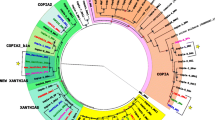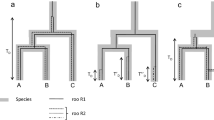Abstract
LTR retrotransposons are the most abundant transposable elements in Drosophila and are believed to have contributed significantly to genome evolution. Different reports have shown that many LTR retrotransposon families in Drosophila melanogaster emerged from recent evolutionary episodes of transpositional activity. To contribute to the knowledge of the evolutionary history of Drosophila LTR retrotransposons and the mechanisms that control their abundance, distribution and diversity, we conducted analyses of four related families of LTR retrotransposons, 297, 17.6, rover and Tom. Our results show that these elements seem to be restricted to species from the D. melanogaster group, except for 17.6, which is also present in D. virilis and D. mojavensis. Genetic divergences and phylogenetic analyses of a 1-kb fragment region of the pol gene illustrate that the evolutionary dynamics of Tom, 297, 17.6 and rover retrotransposons are similar in several aspects, such as low codon bias, the action of purifying selection and phylogenies that are incongruent with those of the host species. We found an extremely complex association among the retrotransposon sequences, indicating that different processes shaped the evolutionary history of these elements, and we detected a very high number of possible horizontal transfer events, corroborating the importance of lateral transmission in the evolution and maintenance of LTR retrotransposons.






Similar content being viewed by others
References
Akaike H (1974) A new look at the statistical model identification. IEEE Trans Automat Contr 19:716–723
Bartolomé C, Bello X, Maside X (2009) Widespread evidence for horizontal transfer of transposable elements across Drosophila genomes. Genome Biol 10:R22
Bergman CM, Bensasson D (2007) Recent LTR retrotransposon insertion contrasts with waves of non-LTR insertion since speciation in Drosophila melanogaster. Proc Natl Acad Sci USA 104:11340–11345
Bowen NJ, McDonald JF (2001) Drosophila euchromatic LTR retrotransposons are much younger than the host species in which they reside. Genome Res 11:1527–1540
Capy P, Langin T, Bigot Y, Brunet F, Daboussi MJ, Periquet G, David JR, Hartl DL (1994) Horizontal transmission versus ancient origin: mariner in the witness box. Genetica 93:161–170
Capy P, Bazin C, Higuet D, Langin T (1998) Dynamics and evolution of transposable elements. Landes Bioscience, Austin, Texas, 197 pp
Coffin JM, Hughes SH, Varmus HE (1997) Retroviruses. Cold Spring Harbor Laboratory Press, Nova York, p 843
Daniels SB, Peterson KR, Strausbaugh LD, Kidwell MG, Chovnick A (1990) Evidence for horizontal transmission of the P transposable element between Drosophila species. Genetics 124:339–355
de Luca Jr M, Carareto CMA, Ceron CR (2007) Distribution of the Bari-I transposable element in stable hybrid strains between Drosophila melanogaster and Drosophila simulans and in Brazilian populations of these species. Genet Mol Biol 30:676–680
Diao X, Freeling M, Lisch D (2006) Horizontal transfer of a plant transposon. PLoS Biol 4:e5
Grantham R, Gautier C, Gouy M, Mercier R, Pavé A (1980) Codon catalog usage and the genome hypothesis. Nucleic Acids Res 11:r49–r62
Graur D, Li W (2000) Fundaments of molecular evolution, 2nd edn. Sinauer Associates, Sunderland, Massachusetts, p 439
Grumbling G, Strelets V (2006) FlyBase: anatomical data, images and queries. Nucleic Acids Res 34:D484–D488
Havecker ER, Gao X, Voytas DF (2004) The diversity of LTR retrotransposons. Genome Biol 5:2251–2256
Herédia F, Loreto EL, Valente VL (2004) Complex evolution of gypsy in Drosophilid species. Mol Biol Evol 21:1831–1842
Jehle JA, Nickel A, Vlak JM, Backhaus H (1998) Horizontal escape of the novel Tc1-like lepidopteran transposon TCp32 into Cydia pomonella granulovirus. J Mol Evol 46:215–224
Kaminker JS, Bergman CM, Kronmiller B, Carlson J, Svirskas R, Patel S, Frise E, Wheeler DA, Lewis SE, Rubin GM, Ashburner M, Celniker SE (2002) The transposable elements of the Drosophila melanogaster euchromatin: a genomics perspective. Genome Biol 2002 3:research0084.1-0084.20
Kent WJ (2002) BLAT—the BLAST-like alignment tool. Genome Res 12:656–664
Kim A, Terzian C, Santamaría P, Pélisson A, Purd’homme N, Bucheton A (1994) Retroviruses in invertebrates: the gypsy retrotransposon is apparently an infectious retrovirus of Drosophila melanogaster. Proc Natl Acad Sci USA 91:285–289
Klein CC, Essi L, Golombieski RM, Loreto ELS (1999) Disgenesia do híbrido em populações naturais de Drosophila melanogaster. Cienc Nat 21:7–20
Kohany O, Gentles AJ, Hankus L, Jurka J (2006) Annotation, submission and screening of repetitive elements in Repbase: RepbaseSubmitter and Censor. BMC Bioinformatics 7:474
Larkin MA, Blackshields G, Brown NP, Chenna R, McGettigan PA, McWilliam H, Valentin F, Wallace IM, Wilm A, Lopez R, Thompson JD, Gibson TJ, Higgins DG (2007) Clustal W and Clustal X version 2.0. Bioinformatics 23:2947–2948
Leblanc P, Desset S, Giorgi F, Taddei AR, Fausto AM, Mazzini M, Dastugue B, Vaury C (2000) Life cycle of an endogenous retrovirus, ZAM, in Drosophila melanogaster. J Virol 74:10658–10669
Lerat E, Rizzon C, Biémont C (2003) Sequence divergence within transposable element families in the Drosophila melanogaster genome. Genome Res 13:1889–1896
Lewis RL, Beckenbach AT, Mooers AØ (2005) The phylogeny of the subgroups within the melanogaster species group: likelihood tests on COI and COII sequences and a Bayesian estimate of phylogeny. Mol Phylogenet Evol 37:15–24
Llorens JV, Clark JB, Martínez-Garay I, Soriano S, de Frutos R, Martínez-Sebastián MJ (2008) Gypsy endogenous retrovirus maintains potential infectivity in several species of Drosophilids. BMC Evol Biol 8:302
Loreto ELS, Carareto CMA, Capy P (2008) Revisiting horizontal transfer of transposable element in Drosophila. Heredity 100:545–554
Ludwig A, Loreto ELS (2007) Evolutionary pattern of the gtwin retrotransposon in the Drosophila melanogaster subgroup. Genetica 30:161–168
Ludwig A, Valente VLS, Loreto ELS (2008) Multiple Invasions of Errantivirus in the genus Drosophila. Insect Mol Biol 17:113–124
Malik HS, Henikoff S, Eickbush TH (2000) Poised for contagion: evolutionary origins of the infectious abilities of invertebrate retroviruses. Genome Res 10:1307–1318
Marzo M, Puig M, Ruiz A (2008) The Foldback-like element Galileo belongs to the P superfamily of DNA transposons and is widespread within the Drosophila genus. Proc Natl Acad Sci USA 105:2957–2962
Morton BR (1993) Chloroplast DNA codon use: evidence for selection at the psb A locus based on tRNA availability. J Mol Evol 37:273–280
Nei M, Gojobori T (1986) Simple methods for estimating the numbers of synonymous and nonsynonymous nucleotide substitutions. Mol Biol Evol 3:418–426
Nicholas KB, Nicholas HB Jr (1997) GeneDoc: a tool for editing and annotating multiple sequence alignments (Distributed by the author). http://www.psc.edu/biomed/genedoc
Nylander JAA (2004) MrModeltest v2. Program distributed by the author. Evolutionary Biology Centre, Uppsala University
Ozers MS, Friesen PD (1996) The Env-like open reading frame of the baculovirus-integrated retrotransposon TED encodes a retrovirus-like envelope protein. Virology 226:252–259
Robe LJ, Valente VLS, Budnik M, Loreto ELS (2005) Molecular phylogeny of the subgenus Drosophila (Diptera, Drosophilidae) with an emphasis on neotropical species and groups: a nuclear versus mitochondrial gene approach. Mol Phylogenet Evol 36:623–640
Ronquist F, Huelsenbeck JP (2003) MrBayes 3: Bayesian phylogenetic inference under mixed models. Bioinformatics 19:1572–1574
Ross CL, Dyer KA, Erez T, Miller SJ, Jaenike J, Markow TA (2003) Rapid divergence of microsatellite abundance among species of Drosophila. Mol Biol Evol 20:1143–1157
Rozas J, Sanchez-DelBarrio JC, Messeguer X, Rozas R (2003) DnaSP, DNA polymorphism analyses by the coalescent and other methods. Bioinformatics 19:2496–2497
Saitou N, Nei M (1987) The neighbor-joining method: a new method for reconstructing phylogenetic trees. Mol Biol Evol 4:406–425
Sassi AK, Herédia F, Loreto ELS, Valente VLS, Rohde C (2005) Transposable elements P and gypsy in natural populations of Drosophila willistoni. Genet Mol Biol 28:734–739
Sharp PM, Li WH (1989) On the rate of DNA sequence evolution in Drosophila. J Mol Evol 28:398–402
Shields DC, Sharp PM, Higgins DG, Wright F (1988) “Silent” sites in Drosophila genes are not neutral: evidence of selection among synonymous codons. Mol Biol Evol 5:704–716
Silva JC, Kidwell MG (2000) Horizontal transfer and selection in the evolution of P elements. Mol Biol Evol 17:1542–1557
Silva JC, Loreto EL, Clark JB (2004) Factors that affect the horizontal transfer of transposable elements. Curr Issues Mol Biol 6:57–71
Song SU, Gerasimova T, Kurkulos M, Boeke JD, Corces VG (1994) An env-like protein encoded by a Drosophila retroelement: evidence that gypsy is an infectious retrovirus. Genes Dev 8:2046–2057
Staden R (1996) The Staden sequence analysis package. Mol Biotechnol 5:233–241
Tamura K, Subramanian S, Kumar S (2004) Temporal patterns of fruit fly (Drosophila) evolution revealed by mutation clocks. Mol Biol Evol 21:36–44
Tamura K, Dudley J, Nei M, Kumar S (2007) MEGA4: Molecular Evolutionary Genetics Analysis (MEGA) software version 4.0. Mol Biol Evol 24:1596–1599
Tanda S, Mullor JL, Corces VG (1994) The Drosophila tom retrotransposon encodes an envelope protein. Mol Cell Biol 14:5392–5401
Terzian C, Ferraz C, Demaille J, Bucheton A (2000) Evolution of the gypsy endogenous retrovirus in the Drosophila melanogaster subgroup. Mol Biol Evol 17:908–914
Vázquez-Manrique RP, Hernández M, Martínez-Sebastián MJ, de Frutos R (2000) Evolution of gypsy endogenous retrovirus in the Drosophila obscura species group. Mol Biol Evol 17:1185–1193
Vicario S, Moriyama EN, Powell JR (2007) Codon usage in twelve species of Drosophila. BMC Evol Biol 7:226
Wicker T, Sabot F, Hua-Van A, Bennetzen JL, Capy P, Chalhoub B, Flavell A, Leroy P, Morgante M, Panaud O, Paux E, SanMiguel P, Schulman AH (2007) A unified classification system for eukaryotic transposable elements. Nat Rev Genet 8:973–982
Witherspoon DJ (1999) Selective constraints on P-element evolution. Mol Biol Evol 16:472–478
Wright F (1990) The ‘effective number of codons’ used in a gene. Gene 87:23–29
Yoshida K, Juni N, Awasaki T, Tsuriya Y, Shaya N, Hori SH (1994) Retrotransposon-induced ectopic expression of the Om(2D) gene causes the eye-specific Om(2D) phenotype in Drosophila ananassae. Mol Gen Genet 245:577–587
Acknowledgments
This work was supported by grants from FAPERGS (0411965) and CNPq. We thank CNPq for fellowships. We thank Agencourt Bioscience Corporation, the Broad Institute, J. Craig Venter Institute, and Washington University School of Medicine Genome Sequencing Center for prepublication access to the genome sequence data. We are grateful to Dr. Henrique Bunselmeyer Ferreira, Dr. Paulo Marcos Pinto, Dr. Lizandra Jaqueline Robe, Dr. Christian Macagnan Probst, MSc. Nina Roth Mota and MSc. Paloma Rubin for the valuable help during the realization of this work. We also thank Dr. K. Yoshida for kindly providing the pXTom2 plasmid; Dr. Damon Lish for statistical test discussion; Dr. Vera Lúcia da Silva Valente, Dr. Marco Silva Gottschalk, Dr. Jean David for providing several Drosophila strains; and two anonymous reviewers for their helpful suggestions on the manuscript.
Author information
Authors and Affiliations
Corresponding author
Additional information
Communicated by T. Clandinin.
Electronic supplementary material
Below is the link to the electronic supplementary material.
These files are unfortunately not in the Publisher's archive anymore:
-
Supplementary material 1 (FASTA 104 kb)
-
Supplementary material 2 (FASTA 84 kb)
-
Supplementary material 3 (FASTA 75 kb)
-
Supplementary material 4 (FASTA 27 kb)
Rights and permissions
About this article
Cite this article
Vidal, N.M., Ludwig, A. & Loreto, E.L.S. Evolution of Tom, 297, 17.6 and rover retrotransposons in Drosophilidae species. Mol Genet Genomics 282, 351–362 (2009). https://doi.org/10.1007/s00438-009-0468-0
Received:
Accepted:
Published:
Issue Date:
DOI: https://doi.org/10.1007/s00438-009-0468-0




